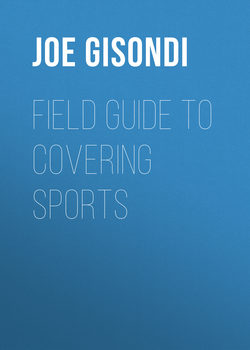Читать книгу Field Guide to Covering Sports - Joe Gisondi - Страница 49
На сайте Литреса книга снята с продажи.
Setting
ОглавлениеPut the person in a place, a physical location, whenever possible. Sometimes you can describe the setting before you describe the profiled person, especially when the setting takes on the role of a character. That’s the case in Colloff’s story about the woman fired as a high school girls’ basketball coach. The town whose morals and beliefs clash with those of the coach is introduced in the beginning of the story, which is titled “She’s Here. She’s Queer. She’s Fired” and was selected as one of the best sports stories of 2005.
Sports Insider: On Writing Precedes
For game advances, at least for football, it’s always an option to try and find on-field match-ups, say a wide receiver and a cornerback, and talk to players who have faced each one. Also, if possible, try and get access to the players as they study tape to prepare for that upcoming game. Whenever I do a feature, I try to research every story I can find about someone. I also will try and talk to as many people from their past, preferably people who knew them before they were stars or whatever. Sometimes you get great anecdotes and color. Sometimes you don’t get much, but I think it’s still a big plus, because at least it gives you an entry point when you talk to the subject, so it might build a comfort zone right away.
Bruce Feldman, FOXSports.com
“I focused on the town as a character, and I started the story by describing the town—for a number of reasons,” Colloff said. “The first one was a practical consideration: It wasn’t basketball season when I was reporting this story, so my options for an opening scene were more limited than they might have been otherwise. More importantly, though, I thought it was essential to ground the reader in the place where this happened, so that the reader could better understand: (1) the enormous importance that high school sports has in such a tiny and remote place, and (2) the cultural/political landscape that Merry Stephens worked in.”
Setting is not always so significant, but putting a person in a place allows the reader to follow more easily. Note the details below.
In Bloomburg there isn’t a stop sign, or even a blinking yellow light, at the center of town—just a bend in a winding two-lane road that meanders through the woods toward the Arkansas state line. Every now and then a logging truck piled high with pulpwood rumbles by on its way to the paper mill, scattering twigs and pine needles onto the blacktop below. Otherwise the town is quiet. There is no Dairy Queen, or any diversions to speak of; the closest movie theater is thirty miles away, in Texarkana. Even Bloomburg’s 1A high school is too small and too poor to have its own football team. But every November, when teenagers scrawl “Go Wildcats!” in white shoe polish on the back windows of their pickups, the boys’ and girls’ varsity basketball teams try to make the town proud.
Bloomburg never had much to brag about until six years ago, when the school district hired a young coach out of Arkansas named Merry Stephens. She was the first female coach in Bloomburg history, and also one of its toughest. When just seven girls tried out for the Lady Wildcats during her first year in Bloomburg, Stephens had them practice by playing against the boys. If they were used to making fifty layups at practice, she told them to do twice as many. It wasn’t long before the Lady Wildcats started winning. Stephens led the team to the state playoffs three times, and in 2004, when the team had grown to 25 players, the Lady Wildcats made it all the way to the final four. “Half the town went with them,” said one parent of the six-hour drive to Georgetown, just north of Austin. “We’d never had a team do so well.” The Lady Wildcats didn’t win the championship, but they were welcomed back as heroes. When the team’s bus pulled into town, people stood on their porches and cheered, and the volunteer fire department led an impromptu parade.
But even after the local Wal-Mart named Stephens Teacher of the Year and the district had chosen her as its Coach of the Year no fewer than three times, many residents felt uneasy about her. Stephens, it was rumored, was a lesbian. And in an area where ministers preach against homosexuality from the pulpit and tracts denouncing the theory of evolution sit next to cash registers in convenience stores, Stephens’ sexual orientation was not an issue that most residents of Bloomburg, or its school board, could overlook. In December, just nine months after the Lady Wildcats had gone to the finals, Stephens was abruptly put on leave. The woman she lived with, a teacher’s aide and school bus driver named Sheila Dunlap, was dismissed. The board’s actions made this otherwise placid town of 374 people erupt in controversy and became the central issue of the school board election in May. “It’s divided this town,” said history teacher Thresha Jones. “You’ve got people who feel that Merry and Sheila were done wrong. And then you’ve got people who think that what the school board did was the only right thing to do.”7
